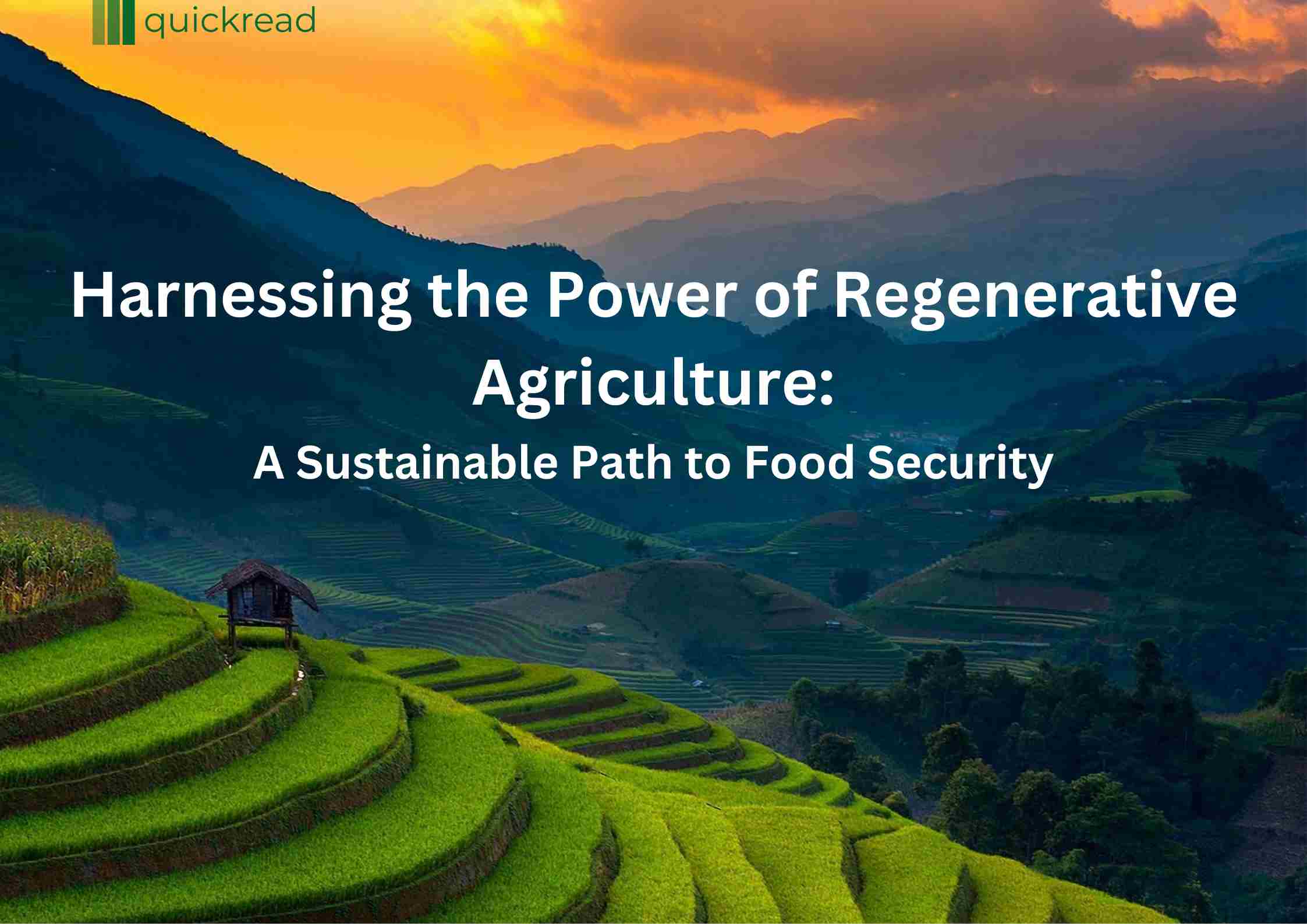Last updated on August 4th, 2023
Introduction
Regenerative agriculture is a holistic approach to farming that focuses on restoring and improving the health of soil, promoting biodiversity, and mitigating the effects of climate change. It goes beyond conventional sustainable practices by actively rejuvenating ecosystems and optimizing the natural processes that sustain agricultural production. This article delves into the key principles and techniques of regenerative agriculture and highlights its benefits in greater detail.
Soil Health and Regeneration

Regenerative agriculture is built on the understanding that strong soil is the cornerstone of long-term food production. Conventional farming methods, such as excessive tillage and heavy reliance on synthetic fertilizers and pesticides, can degrade soil quality over time. Regenerative practices aim to reverse this trend and rebuild soil health.
One of the primary strategies employed in regenerative agriculture is the use of cover crops. These are planted between cash crops to protect the soil from erosion, improve water infiltration, and enhance organic matter content. Cover crops also enhance microbial activity, promoting nutrient cycling and reducing the need for synthetic inputs.
Another crucial aspect of soil regeneration is crop rotation. By diversifying the types of crops grown on a piece of land, farmers can break pest and disease cycles, improve soil structure, and optimize nutrient availability. Additionally, incorporating perennial crops, such as fruit trees or nitrogen-fixing plants, helps build deep root systems and enhances soil stability and fertility.
Benefits for Soil Health
Regenerative agriculture offers several benefits for soil health:
- Increased Organic Matter: Regenerative practices lead to higher organic matter content in the soil, improving its water-holding capacity, nutrient retention, and overall fertility.
- Enhanced Soil Structure: By promoting the growth of beneficial soil organisms, such as earthworms and mycorrhizal fungi, regenerative practices improve soil structure, making it more resilient against erosion and compaction.
- Improved Nutrient Cycling: Regenerative techniques encourage the natural cycling of nutrients, reducing the need for synthetic fertilizers. This not only reduces environmental pollution but also reduces production costs for farmers.
Water Conservation and Quality

Regenerative agriculture plays a crucial role in water conservation and quality management:
- Water Retention: Healthy soils with higher organic matter content have improved water-holding capacity, reducing water runoff and enhancing water infiltration. This helps mitigate the risks of droughts and floods.
- Reduced Erosion: By protecting the soil with cover crops and minimizing tillage, regenerative practices prevent soil erosion, keeping sediment and contaminants out of water bodies.
- Groundwater Recharge: Improved soil structure and increased organic matter enable better water percolation, allowing groundwater recharge and maintaining adequate water levels.
Climate Change Mitigation
Regenerative agriculture offers significant potential for mitigating climate change:
- Carbon Sequestration: By increasing the organic matter content in soils, regenerative practices enhance carbon sequestration. The soil acts as a carbon sink, removing carbon dioxide from the atmosphere and storing it long-term.
- Reduced Greenhouse Gas Emissions: By minimizing the use of synthetic fertilizers and pesticides, regenerative agriculture reduces the release of greenhouse gases associated with their production and application.
- Resilience to Climate Extremes: Regenerative practices improve the soil’s ability to withstand extreme weather events, such as droughts and heavy rainfall. This resilience is crucial in adapting to the changing climate.
Enhancing Biodiversity and Ecosystem Resilience
Regenerative agriculture promotes biodiversity and strengthens ecosystem resilience:
- Habitat Creation: By incorporating diverse crops, planting hedgerows, and preserving natural habitats, regenerative farmers create favorable conditions for beneficial insects, pollinators, and other wildlife. This contributes to biological pest control and enhances overall ecosystem health.
- Increased Resilience: Biodiversity acts as a buffer against pests and diseases, reducing the need for chemical interventions. A diverse ecosystem is more adaptable to environmental changes, ensuring the long-term viability of agricultural systems.
Core principles of Regenerative agriculture
Regenerative agriculture is guided by several core principles that shape its approach to farming and land management. These principles are based on the understanding that agriculture can play a vital role in revitalizing ecosystems, improving soil health, promoting biodiversity, and mitigating climate change. Here are the core principles of regenerative agriculture:
- Soil Health: Regenerative agriculture prioritizes the restoration and enhancement of soil health. It recognizes soil as a living ecosystem and focuses on practices that build soil organic matter, improve soil structure, increase microbial activity, and promote nutrient cycling. By nurturing healthy soils, regenerative agriculture supports plant growth, reduces the need for synthetic inputs, and enhances long-term productivity.
- Conservation and Regeneration: Regenerative seeks to conserve and regenerate natural resources rather than deplete them. It emphasizes the protection of soil, water, and biodiversity, recognizing their interconnectedness and importance in maintaining ecosystem resilience. Conservation practices, such as minimizing soil erosion, promoting water retention, and preserving natural habitats, are integral to regenerative systems.
- Biodiversity Enhancement: Promoting biodiversity is a central principle of regenerative agriculture. By diversifying crops, incorporating native plants, establishing hedgerows, and preserving natural habitats, regenerative farmers create environments that support a wide range of beneficial organisms. Biodiversity enhances ecosystem resilience, improves pest control, and promotes pollination, leading to more sustainable and resilient agricultural systems.
- Water Management: Regenerative agriculture emphasizes efficient water management. Techniques such as contour plowing, cover cropping, and mulching are employed to reduce water runoff, increase water infiltration, and minimize soil moisture loss. By optimizing water use and conserving water resources, regenerative practices contribute to drought resilience and enhance overall water quality.
- Climate Change Mitigation: Regenerative recognizes its role in addressing climate change by actively mitigating greenhouse gas emissions and enhancing carbon sequestration. Practices such as agroforestry, cover cropping, rotational grazing, and composting promote carbon storage in soils and biomass, reducing the concentration of greenhouse gases in the atmosphere. By integrating climate-friendly practices, regenerative agriculture helps combat climate change while building agricultural resilience to its impacts.
- Collaboration and Knowledge Sharing: Regenerative agriculture encourages collaboration and knowledge sharing among farmers, scientists, policymakers, and consumers. Sharing experiences, best practices, and research findings allows for continuous improvement and innovation in regenerative farming systems. Collaboration also helps create supportive networks and fosters a sense of community among those involved in regenerative agriculture.
These core principles of regenerative agriculture provide a framework for farmers to adopt practices that restore and enhance the health of ecosystems, promote sustainable food production, and contribute to the overall well-being of the planet.
Conclusion
Regenerative agriculture offers a transformative and sustainable approach to farming that prioritizes soil health, biodiversity, and climate change mitigation. By implementing regenerative practices, farmers can restore soil fertility, conserve water resources, mitigate climate change, and enhance ecosystem resilience. Embracing regenerative agriculture at a global scale has the potential to revolutionize the way we produce food, ensuring a secure and sustainable future for generations to come.


